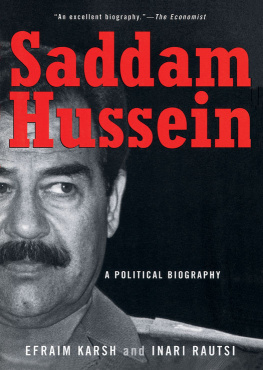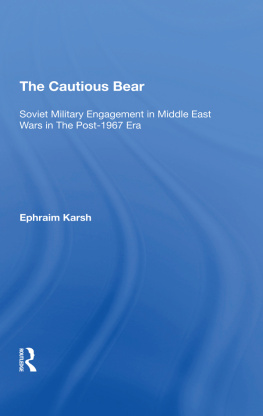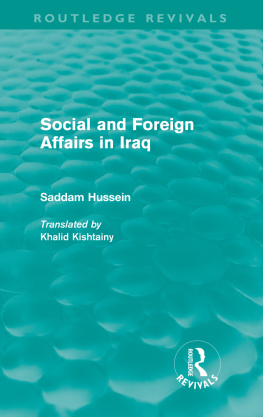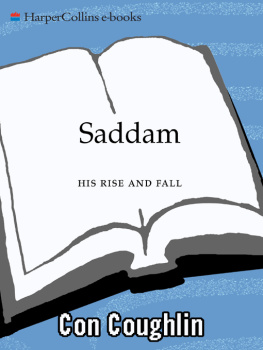Efraim Karsh - Saddam Hussein: A Political Biography
Here you can read online Efraim Karsh - Saddam Hussein: A Political Biography full text of the book (entire story) in english for free. Download pdf and epub, get meaning, cover and reviews about this ebook. City: New York, Array, year: 2003, publisher: Grove Press, genre: Detective and thriller. Description of the work, (preface) as well as reviews are available. Best literature library LitArk.com created for fans of good reading and offers a wide selection of genres:
Romance novel
Science fiction
Adventure
Detective
Science
History
Home and family
Prose
Art
Politics
Computer
Non-fiction
Religion
Business
Children
Humor
Choose a favorite category and find really read worthwhile books. Enjoy immersion in the world of imagination, feel the emotions of the characters or learn something new for yourself, make an fascinating discovery.
- Book:Saddam Hussein: A Political Biography
- Author:
- Publisher:Grove Press
- Genre:
- Year:2003
- City:New York, Array
- Rating:5 / 5
- Favourites:Add to favourites
- Your mark:
- 100
- 1
- 2
- 3
- 4
- 5
Saddam Hussein: A Political Biography: summary, description and annotation
We offer to read an annotation, description, summary or preface (depends on what the author of the book "Saddam Hussein: A Political Biography" wrote himself). If you haven't found the necessary information about the book — write in the comments, we will try to find it.
Saddam Hussein: A Political Biography — read online for free the complete book (whole text) full work
Below is the text of the book, divided by pages. System saving the place of the last page read, allows you to conveniently read the book "Saddam Hussein: A Political Biography" online for free, without having to search again every time where you left off. Put a bookmark, and you can go to the page where you finished reading at any time.
Font size:
Interval:
Bookmark:


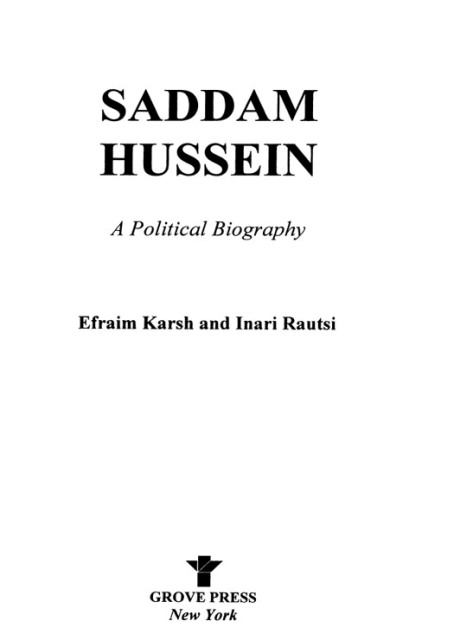
Copyright 1991 by Efraim Karsh and Inari Rautsi
Revised introduction and epilogue copyright 2002 by Efraim Karsh
All rights reserved. No part of this book may be reproduced in any form or by any electronic or mechanical means, including information storage and retrieval systems, without permission in writing from the publisher, except by a reviewer, who may quote brief passages in a review. Any members of educational institutions wishing to photocopy part or all of the work for classroom use, or publishers who would like to obtain permission to include the work in an anthology, should send their inquiries to Grove/Atlantic, Inc., 841 Broadway, New York, NY 10003.
First published in Great Britain in 1991 by Brassey's
This edition published in the Great Britain in 1991 by Futura Publications, a division of Macdonald & Company, Ltd., London
Published simultaneously in Canada
Printed in the United States of America
Library of Congress Cataloging-in-Publication Data
Karsh, Efraim.
Saddam Hussein : a political biography / Efraim Karsh and Inari Rautsi.
p. cm.
Includes bibliographical references (p. ) and index.
ISBN 9780802199546
1. Hussein, Saddam, 1937 2. PresidentsIraqBiography. 3. IraqPolitics and government. I. Rautsi, Inari. II. Title.
DS79.66.H87 K37 2003
956.7044'092dc21
[B] 2002035344
Grove Press
841 Broadway
New York, NY 10003
03 04 05 06 07 10 9 8 7 6 5 4 3 2
Contents
Acknowledgments
Our thanks are due to many individuals in Europe, the Middle East and the United States who generously shared their time and knowledge with us. In addition to those who wish to remain anonymous, we are particularly indebted to Fred Halliday, Charles Tripp, Peter Sluglett, Richard Murphy, Lawrence Freed-man, Ofra Bengio, Philip Sabin and Joseph Mekelberg.
A good editor is of immeasurable help. We were fortunate to have one in the person of Joyce Seltzer.
Needless to say, the responsibility for what follows is ours and ours alone.
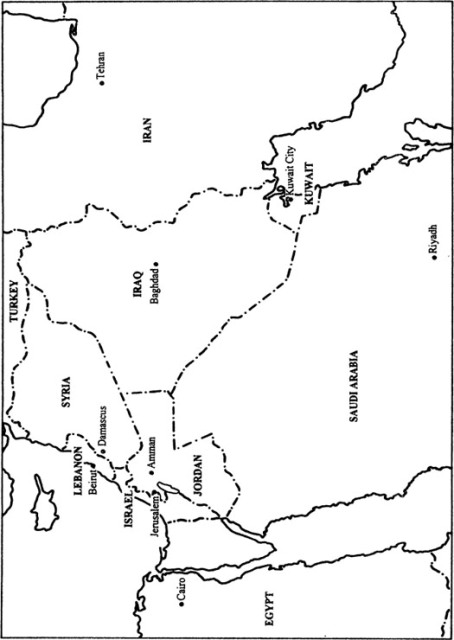
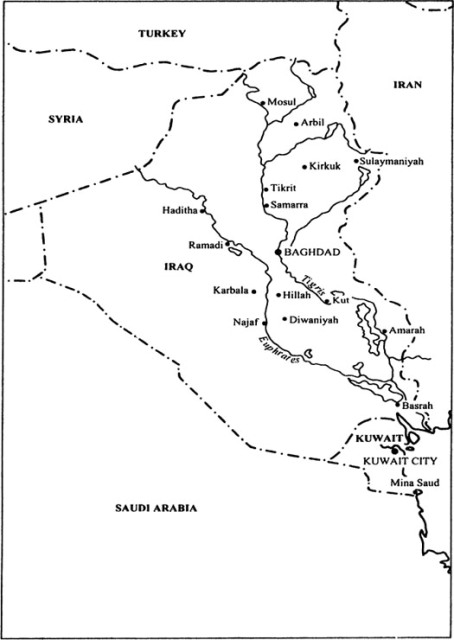
Introduction: The Man and His World
F rom inside America how four planes flew. Such a mishap never happened in the past! And nothing similar will happen. Six thousand infidels died. Bin Laden did not do it; the luck of the [Iraqi] President did it.
The sheik finished reciting the poem and withdrew to his seat. The other tribal chieftains clapped enthusiastically. Their meeting with their absolute leader was being televised for screening on prime time, and they were on their best behavior. The camera then moved to President Saddam Hussein. He gave a small regal nod in the direction of his admiring subjects. His face showed little emotion, yet his lips twisted in a barely perceptible smile of self-satisfaction. He had just been credited, in front of his entire nation, with being the moving spirit behind what was regarded in the West as the worst-ever terrorist atrocity, but was applauded by many Arabs and Muslims as a heroic act of retribution against American imperialism and he seemed to be enjoying the compliment.
Did Saddam have anything to do with the September 11 atrocity? The various attempts to link him to the attack have failed to produce conclusive proof, though Iraq apparently trained al-Qa'eda fighters during the 1990s and sheltered scores of terrorists fleeing the American offensive in Afghanistan. Nor did Bin Laden need Saddam's inspiration: his hatred for the United States was far more ideological, if no less intense, than that of the Iraqi So was his frustration with the reversal of Iraq's nonconventional weapons program. The United States had jeopardized his attempts to recover from the debilitating effects of the Iran-Iraq War (1980-88) and had put his personal rule in mortal danger, and Saddam was neither forgetful nor forgiving. The desire for revenge was burning. And although he might not be in a position to take revenge on his own, he was not going to shed many tears if somebody else did.
As early as his meeting with the U.S. ambassador to Baghdad, Ms. April Glaspie, on July 25, 1990, a few days before his invasion of Kuwait, Saddam threatened the United States with terrorist attacks if it stood in his way. We cannot come all the way to the United States, he said, but individual Arabs may reach you. Now that this threat had been carried out, Saddam was beside himself with joy. The American people should remember that, throughout history, no one crossed the Atlantic to come to them, carrying weapons against them, he gloated a day after the September 11 attack, before blaming the victim for the tragedy that had just befallen it:
The United States reaps the thorns that its leaders have planted in the world. These thorns have not only caused the feet and hearts of certain people to bleed, but also caused the eyes of people to bleedthose people who wept a lot over their dead. This was the case in Japan, which was the first to suffer from the capabilities of nuclear destruction on which the United States prides itself. This also includes what it did in Vietnam and Iraq and what it did against the Russian nuclear submarine.
The United States has become a burden on all of us. It threatens our security and that of the world on a daily basis, Saddam lamented. Why do you drive the world to this point, and why do you stab the world with a dagger?
This was not the first time Saddam blamed the United States of backstabbing Iraq. Precisely eleven years earlier he used the same metaphor to justify his invasion of Kuwait. The ruling family in Kuwait is good at blackmail, exploitation, and destruction of their
To world public opinion, this explanation seemed a flimsy excuse for an unprovoked act of aggression by a regional giant against a hapless neighbor. And yet, however absurd it might seem to outsiders, for Saddam the Kuwaiti conspiracy was a very real threat. His distorted interpretation of the origins of the crisis illustrates the driving force of the Iraqi leader: an overriding insecurity arising from a strikingly cynical worldview. The bleak vision of humanity, memorably described 350 years ago by the political philosopher, Thomas Hobbes, best describes Saddam's outlook on life. He perceives the world as a violent, hostile environment in which the will to self-preservation rules. In such a setting, as Hobbes says, the war of all against all is constant and man is condemned to a life that is solitary, poor, nasty, brutish, and short.
In the permanently beleaguered mind of Saddam, politics is a ceaseless struggle for survival. The ultimate goal of staying alive, and in power, justifies all means. Plots lurk around every corner. Nobody is trustworthy. Everybody is an actual or potential enemy. One must remain constantly on the alert, making others cower so that they do not attack, always ready to kill before being killed. I know that there are scores of people plotting to kill me, Saddam told a personal guest of his shortly after assuming the presidency in the summer of 1979, and this is not difficult to understand. After all, did we not seize power by plotting against our predecessors? However, he added, I am far cleverer than they are. I know they are conspiring to kill me long before they actually start planning to do it. This enables me to get them before they have the faintest chance of striking at me.
Next pageFont size:
Interval:
Bookmark:
Similar books «Saddam Hussein: A Political Biography»
Look at similar books to Saddam Hussein: A Political Biography. We have selected literature similar in name and meaning in the hope of providing readers with more options to find new, interesting, not yet read works.
Discussion, reviews of the book Saddam Hussein: A Political Biography and just readers' own opinions. Leave your comments, write what you think about the work, its meaning or the main characters. Specify what exactly you liked and what you didn't like, and why you think so.

